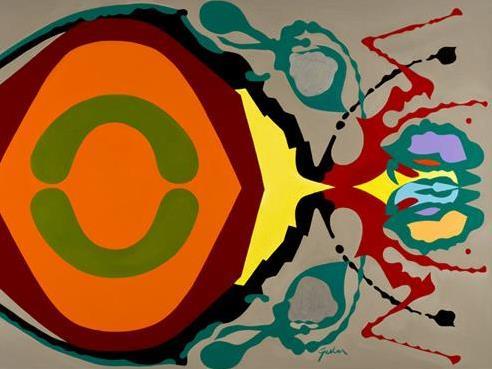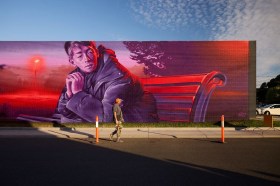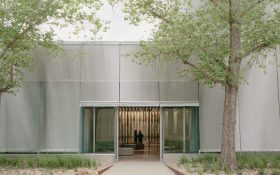Matthys Gerber, Monitor, 2008.
Matthys Gerber seems restless. Born in Delft, Netherlands, he unwillingly moved to Australia as a teenager in 1972. In an interview with the Fenella Kernabone in 2009 the artist confesses that it took him ‘twenty years to like Australia’. It is perhaps this physical unrest that is reflected in Gerber’s refusal to adhere to a specific genre of painting. Instead he has allowed himself the freedom of unbridled experimentation, traversing history and cultural context.
The career survey exhibition at the Museum of Contemporary Art negotiates Gerber’s heterogeneous paintings by taking a ‘more-is-more’ approach. The walls of the level one gallery are laden with a mélange of artworks that oscillate between genres: abstraction, portraiture, landscape, still life and text. Curator Natasha Bullock made the auspicious decision to punctuate the exhibition with works that reveal some of Gerber’s influences, including a painting by Pupunya Tula artist George Tjungurrayi, and another by conceptual artist Tim Johnson in collaboration with Tommy Stevens Tjakamarra. An original photograph of an Yves Klein performance, and an original print by Georges Mathieu from the artist’s personal collection are also included. This may not have been as successful in an exhibition of aesthetic consistency, however amongst Gerber’s eclectic oeuvre these works provide context without looking incongruous.
In an exhibition so overwhelmed with variation of imagery and ideas, the connecting threads remain visible. Opposing forces in Gerber’s work provoke a perpetual struggle between order and chaos. Images appear to break down, then reassemble, to varying degrees. Portraits range from photorealistic representations, to degraded, pixelated, highly-saturated abstractions. Hard-edged geometric shapes dissolve into fluid, gestural expressions. Text, lines and symbols contort language and form.
Gerber’s work challenges the perception of taste. His use of colour is not cheerful, but often garish. He creates tension by pushing the boundaries of bourgeois palatability. Familiar imagery is cloaked in irony, paintings are rendered kitsch and ostentatious. Sex and Mysticism are emergent themes. Rorschach-inspired ink blot paintings and hard-edged geometric abstractions are imbued with sexual innuendo; portraits are openly erotic.
An open structure made of marine ply provides additional wall space in the centre of the gallery, apparently designed to reference a Rorschach ink blot in geometric form. This intention is not obvious, but rather the grainy wood cladding feels organically ephemeral, and augments the spiritual facade of his landscape paintings. In this context, Holy War II (1994), one of the earliest examples of Gerber’s mirroring technique, looks like a poster hanging in the back of a crystal healing pop-up shop. The New Age sentiment is further expressed in Let it be me (1988), a text-based painting that adapts a generic ‘eastern’ design and offers what Mitchell Cumming describes in his catalogue essay as ‘bubblegum transcendency’.
Gerber challenges the colloquial traditions of Australian painting, he prioritises ideas: new and re-interpreted. He is incessantly experimental, as unsettled in his approach to painting as in his choice of subject, style or genre. The artist employs irony (Postmodernism’s trump card) to expose myths of sexuality, spirituality and social currency. However ironic, there is a cynical undercurrent in Gerber’s work that feels uncomfortable, and causes the viewer to question the artist’s sincerity.
As a sum of its parts the exhibition may not add up, but the immersive experience proves contrary. Gerber’s confident approach to art–making scoffs at Australia’s cultural cringe and it is discernible that a new generation of artists have largely benefited from the artist’s influence as a teacher and mentor.
Rating: 3 stars out of 5
Matthys Gerber
Museum of Contemporary Art Australia
Level 1 Galleries
22 September – 6 December 2015
FREE entry





